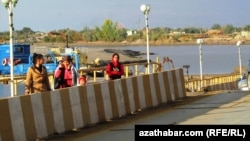About 1,000 years ago, on the territory of modern-day Afghanistan, Mahmud, the ruler of the Ghaznavids, ordered his engineers to build a boat-bridge across the Amu-Darya River. Mahmud used the bridge to invade Transoxania, in what is now modern-day Central Asia.
For the last two years there has been fighting in northern Afghanistan, just across the Amu-Darya River. The situation has gradually grown worse. Central Asia is in no danger of being invaded, but the governments of bordering Tajikistan, Uzbekistan, and Turkmenistan are concerned about the potential implications of Afghanistan's problems for their own security situations, even more so since some of their nationals are members of the militant groups in Afghanistan.
The breakdown in security in northern Afghanistan has coincided with a severe downturn in the economies of Central Asia, so the frustration is rapidly mounting in Ashgabat, Tashkent, and Dushanbe.
In the last week there has been plenty to worry about along the Afghan border.
RFE/RL's Uzbek Service, known locally as Ozodlik, and RFE/RL's Tajik Service, known locally as Ozodi, and RFE/RL's Turkmen Service, known locally as Azatlyk, have been closely following recent events along the Central Asian-Afghan border.
Since July 26, there has been fierce fighting in the Qoshtepa district of Afghanistan's Jowzjan Province, which borders Turkmenistan and is very close to the southwestern tip of Uzbekistan.
Jowzjan Governor Rahmatullah Azizi told RFE/RL's Uzbek Service there were some 500 militants involved in the attacks in Qoshtepa. Azizi said most of the militants were (Afghan) Taliban, but there were also Pakistanis and Uzbeks.
According to Azizi and Haji Ubaidullah, an Arbaky paramilitary commander in the Qoshtepa district, these Uzbeks are remnants of the Islamic Movement of Uzbekistan (IMU). But that is no longer what they call themselves. These Uzbeks are from a new organization called the Termezi group. There appear to be only about 50 of them but they are playing leading roles among the militant groups in Jowzjan, acting as instructors and teaching how to build improvised explosive devices (IEDs).
From Bad To Alarming
The day after fighting started in Qoshtepa, Uzbek President Islam Karimov chaired a meeting of the country's Security Council. The topic was security along the southern border. There were subsequently unconfirmed reports that the order was given to strengthen forces along the Afghan border.
RFE/RL's Gandhara website reported recently about Uzbek security forces crossing into Afghanistan and taking Afghans back into Uzbekistan. The areas just south of Tajikistan are where the security problems began several years ago. The situation in northeastern Afghanistan since then has alternated between bad and alarming.
RFE/RL's Turkmen Service spoke with some locals in Afghanistan's Kunduz Province who live in villages along the Amu-Darya, across from Tajikistan but also very near Uzbekistan. They told RFE/RL's Turkmen Service there are militants sheltering on some of the islands in the Amu-Darya. They were sure, they said, because some of the militants regularly cross the river to Afghanistan to get food.
The city of Kunduz, the capital of Kunduz Province, briefly fell to Taliban and militant forces at the end of September 2015. There has been fighting around the city all this year and some local officials have voiced concerns that the militants could capture Kunduz city again.
Heavy fighting has also taken place in the Qala-i Zal district of Kunduz Province, which borders Tajikistan's Khatlon region.
Local Arbaky commander Muhammad Nabi Kechi said the "Taliban and foreign mercenaries" partially or fully controlled 45 of about 50 villages in Qala-i Zal district. He said they had not yet reached the Amu-Darya but they were close.
Further east, in the neighboring Dasht-i Archi district, there has also been fighting for weeks and militants now seem to control most of the district. That fighting has spilled over into the Hojagor district of the neighboring Takhar Province, which also borders Tajikistan's Khatlon region. The militants have already captured some villages in Hojagor.
Takhar Province Governor Muhammadyosin Ziyo told RFE/RL's Uzbek Service that Afghan government forces are preparing an operation against the militants to drive them out, but there have been no reports saying that operation has started. Information from RFE/RL correspondents in the area suggest there are not even any preparations being made for this security operation.
Wary Truck Drivers
As to claims that the Taliban has actually captured and occupied villages in these northeastern provinces of Afghanistan, it is worth mentioning that the Taliban has not claimed this in any statements.
Tajikistan has been strengthening its border with Afghanistan for several years with help from Russia, China, the United States, NATO, and the European Union. The border is far from being 100-percent sealed but Tajik forces are well positioned and provisioned to repel any attempted incursions.
The more immediate problem is that the fighting has shut down what had been growing cross-border trade between Tajikistan and Afghanistan, easily the most vibrant trade Afghanistan has with any Central Asian country. Some days the border is closed. In Tajikistan, there are a dwindling number of truck drivers willing to take the risk of making the trip into Afghanistan because of the breakdown in the security situation.
Similarly, Turkmenistan's plans to build a railway and a gas pipeline through Afghanistan have been stymied by the outbreak of fighting just across the border. Turkmenistan has also taken to increasing the guard and establishing new fortifications on its border with Afghanistan.
Trade with Central Asia was supposed to have helped Afghanistan recover economically and bring stability back to the country. Instead, the continued fighting in northern Afghanistan is forcing its Central Asian neighbors to further close themselves off.











